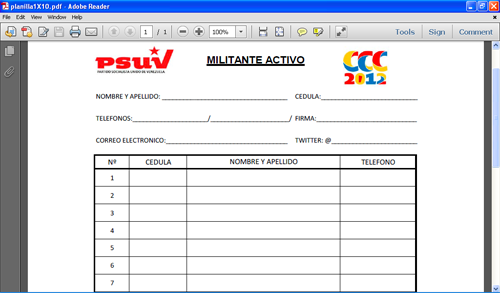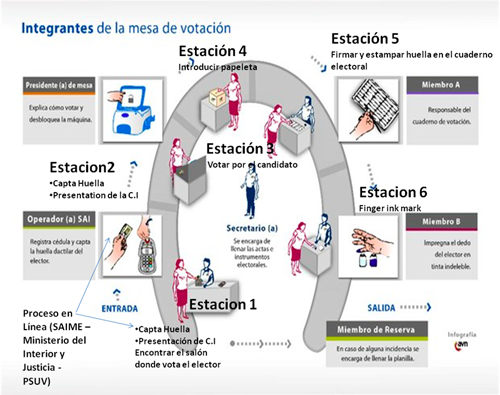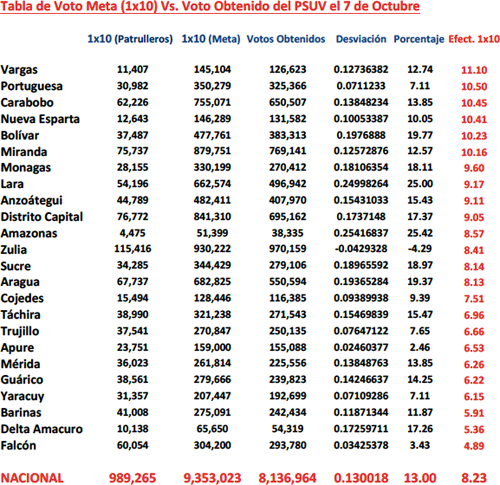





|
Tweet
|
|
|
Last October 7th Hugo Rafael Chavez Frias was elected President of the Bolivarian Republic of Venezuela for a third consecutive term. Which was the key element that allowed him to secure his victory despite having negative elements against him such as his health and poor governance? The re-engineering of the electoral process. In this regard, the electoral process is divided in three sub-processes: development of the election campaign, exercising the right to vote and guaranteeing the results. Development of the election campaign (coercion). This sub-process, according to the Chavez` view, aims at reinforcing the fear factor of the voters who already have, or wish to have, a benefit from the government's social programs. These programs, called "Missions", intend to satisfy the basic needs of the population: health, housing and food, among other. (7) It is through the so-called Missions, that the Chavez´ government has exerted a social control over society, especially on the least-privileged people which comprise the population´s middle and lower classes grouped in C, D and E (80%). (5) The development of an intimidating campaign that uses fear as a social-control mechanism, establishes the risk or the threat of losing the current or future mission's benefit if not voting for Chavez. This advertising is constantly reiterated by the Chavez´ propaganda and by the government's social communications public media and even more so by the State television (VTV1), which may be viewed in open signal all over the country, mainly by the social classes C, D y E2, as a way to embed a learned fear thus creating a coercion that's both political and electoral. (6)(1) This electoral coercion is done through the PSUV's activists or patrols that are in charge of recruiting ten people and guaranteeing their participation on Election Day. The main goal of this strategy, called 1x10, is to persuade voters of the Government´s benevolence and the risks of having a different party in power. The list 1x10, shown in the chart below, provides the identity card number, name, last name and telephone of each registered voter. (2) Likewise all throughout the bullying campaign, the conclusion of a detailed and structured planning of the polling stations takes place as well, aiming at creating favorable conditions for voters at those polling stations historically won by Chavez. On the contrary, those polling stations lost by Chavez face delaying procedures in order to discourage the participation of the opposition groups. A key element to reinforce the intimidating messages is through the Red Spots (Puntos Rojos) that are installed in emblematic spots and with high pedestrian traffic. These stations are equipped with a sunshade, chairs, table, stereos, TV and DVD. The spreading and distribution of propaganda for political blackmailing purposes is ensured in these places. Exercising the right to vote. The main goal of this sub process is to secure the participation of those voters that are State dependent in many different ways like public employees, beneficiaries of the Missions and social programs, etc. One of the keys to success is the registration and organization of the voters recruited from the 1x10 lists, as they are emotionally intimidated because of the electoral campaign. Similarly, the readiness of the polling places fosters the achievement of the estimated result through the 1x10 lists. (3) At the voter information stations (1 and/or 2 in the above layout known as "horseshoe"), in real time identity appropriation through the fingerprints or identity card number obtained from the Identification Administrative System (SAI for its Spanish acronym) discloses immediately who is voting.(8) It is through the database that comes from the 1x10 list from each polling station that the Carabobo Command and the United Socialist Party of Venezuela (PSUV) control who voted. Also the total number of voters per polling station is disclosed through the electoral roll, as well as the historical abstinence records from previous elections. With the results of the exit polls done at midday, a voting trend is estimated so that the Carabobo Command´s Situation Room evaluates the different scenarios to secure victory not leaving anything to chance. Hence, it is determined if the assistance or participation of the registered voters in the 1x10 list, assures the results expected by the PSUV. This is how in the afternoon of October 7th the PSUV requests voters from the list 1x10 to leave their homes or calls them to come to the corresponding polling station. At this moment intimidation exerts its greatest influence as it combines the mobilization with the lack of privacy while voting. In Station 3 of the "horseshoe", the screen that covers the electronic card measures 10 inches high, allowing members of the electoral table and/or the patrol to see for whom each person votes. Consequently, all throughout Election Day the Carabobo Command had at its disposal the information technologies in order to know who to approach, what to tell voters and what to demand from the list 1x10 voters. In order to guarantee the transportation of these voters the government provides vast resources to serve this purpose, from motorcycles, autobuses, standard and heavy-duty vehicles. The results of the table below show the effectiveness of the government´s recruitment strategy of the lists 1x10 in the different states: (4) Guaranteeing the results. In this sub-process the National Electoral Council (CNE for its Spanish acronym), in an alliance with the United Socialist Party of Venezuela (PSUV for its Spanish acronym), defines the right moment to close the voting centers, depending on the voters´ assistance and the election results. This is how, based on a principle of "irrevocable trend", the winner is announced, not even taking into account if all of the polling stations are closed. Consequently, once the winner is announced, if the members of the voting booth are still voting and happen to be against the announced winner will feel discouraged and, in some cases, will leave the polling place giving greater advantage to the PSUV. In conclusion, certainly Chavez and his political party, the PSUV, have managed to formulate a reengineering of the Venezuelan electoral process through the use of information technology, social control (intimidation) over the prevalent groups and the alignment of the CNE, key elements that have allowed him to retain political power in Venezuela. Bibliographic References
1. Monitoreo Ciudadano (2012): Contador de horas de Hugo Chavez en Cadena Nacional de Radio y Televisión durante el año electoral 2012. http://monitoreociudadano.org/cadenometro/. Consulted on: October 11, 2012.
2 http://monitoreociudadano.org/cadenometro/ |



